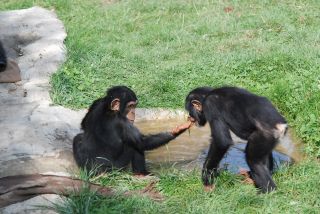Attention
The Chimpanzee and the Moon
Declarative pointing might not be uniquely human.
Posted December 23, 2022 Reviewed by Tyler Woods
Key points
- The pointing gesture used to show something is an important part of human communication.
- Chimpanzees in captivity point in order to get something, but they are bad at understanding the human pointing gesture.
- Pointing declaratively, to direct the attention of another to an object, was thought to be unique to humans.
- New observations indicate that chimpanzees also show objects to each other, although very rarely.
One signal that is crucial to human communication is the pointing gesture to show something. Observe yourself and count how many times in a day you point with your finger at something.
Unlike words, pointing itself has no clear meaning. If I point to a drawer, my husband doesn't know what I mean. But if he's in the middle of looking for his cell phone, it's immediately clear to him what I'm trying to say: "The cell phone is in the drawer." This is a prerequisite for the pointing gestures: both the sender and the receiver must know the context. In our example, it is the cell phone search that my husband and I have known about.
Pointing in human children
Kids start to point at something with their outstretched index finger when they are only a few months old. Why do they point before they start to talk? Often, they use the pointing gesture in a demanding way. They simply want to get something. They point at their bottle, at the cookies, or at the toy they would like to have. But kids also have—at least—two other motives behind pointing.
First, they point to inform others about something in order to be helpful. For example, children as young as one year of age show an adult where an object is that the adult has lost—similar to me when I help my husband to find his phone (Liszkowski et al. 2008).
Second, they point declaratively, that is, to simply direct the attention of another other to an object. For example, kids point to the moon in the sky. It does not mean that they want the moon. Rather, they want to talk about the moon, to share the experience of seeing the moon. Declarative pointing was always considered to be something uniquely human (Tomasello 2019).

Pointing in chimpanzees
But there are new observations indicating that one chimpanzee also shows another chimpanzee, well, not the moon, but a leaf. A team of researchers documented the activities of a wild chimpanzee in Uganda's Kibale National Park, where they captured on video how an adult female chimpanzee, Fiona, showed a leaf to her mother, Sutherland (Wilke et al. 2022). It is a short scene, but it might change how we perceive ourselves—and our closest living relatives. The researchers conclude that maybe—in highly specific social conditions, wild chimpanzees, like humans, may use showing gestures to direct others’ attention to objects simply for the sake of sharing.
We already knew that great apes in captivity point with their hands and fingers to the things they want to get. Chimpanzees also show hidden objects to humans if there are getting something out of it. But they are very bad at understanding the human pointing gesture, and until the new observation, it was believed that their pointing was always demanding. But now Fiona has shown a leaf to Sutherland!
Similarities and differences
If you observed a human child with their mother, you would find many incidences of each showing objects to the other simply for the sake of sharing within an hour. Those chimpanzees, on the other hand, are observed for thousands of hours—and the researchers just found one scene like that. Thus, chimpanzees are, in principle, able to share their attention, but they do so only rarely. As the scientists put it: the difference between humans and our closest living relatives in this regard may be quantitative rather than qualitative.
References
Liszkowski, U., M. Carpenter and M. Tomasello (2008). "Twelve-Month-Olds Communicate Helpfully and Appropriately for Knowledgeable and Ignorant Partners." Cognition 108(3): 732-739.
Tomasello, M. (2019). Becoming Human: A Theory of Ontogeny. Cambridge (Massachusetts), Belknap Press
Wilke, C., N. J. Lahiff, K. H. Sabbi, D. P. Watts, S. W. Townsend and K. E. Slocombe (2022). "Declarative referential gesturing in a wild chimpanzee (<i>Pan troglodytes</i>)." Proceedings of the National Academy of Sciences 119(47): e2206486119.


